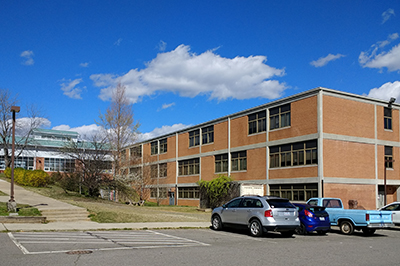Functional Areas
Functional Areas
Drop-off Area(s) (DA)
a. The closest spot to the street of the drop-off areas is at least 50 feet away from public traffic. b. Total length to drop- off or pick-up student. c. School bus leading areas are separated from parent drop-off. d. Drop-off areas do not impede traffic.
From the supporting literature (linked), providing convenient drop-off areas increases school-to-home travels. The separation between car and bus entrance and exit is necessary. It was also noted that the designed driveway and drop-off areas should avoid congestion and provide safe access for roads or streets.
Vehicle Driveway (VD)
Drivers that lead to bus and parent drop-off areas are independent and not connected.
From the supporting literature (linked), the following were suggested;
– Establish a school transportation safety committee.
– Organize a structured arrival and dismissal procedure.
– Provide adult monitors to assist in managing pick-up and drop-off times.
– Prohibit certain turning movements
– The separation between car and bus entrance and exit is necessary.
– The designed driveway and drop-off areas should avoid congestion and provide safe access for roads or streets.
The literature discussed that the presence of a driveway or turning bay on the school entrance decreases both crash occurrence and injury severity.
Direction Window Face in a room.
From the supporting literature (linked above), Northern and Southern classroom orientations improve energy saving in buildings. Classroom window orientation influences the amount of air that goes in and out of a classroom, and also the quality of indoor air.
Parking
The total number of parking spaces.
From the supporting literature (linked), the following were suggested;
– Promote increased roles of teachers, students, parents, and community in recovering unowned school premises.
– Prohibit certain turning movements
– Provide design features to improve educational quality such as; underground parking.
– Proximity of parking lots impact learning.
American Disabilities Act (ADA)
Providing standardized accommodations and access for students, teachers, and staff with disabilities.
From the supporting literature (linked), accessibility for disabled students should be considered during schools’ renovations. Referring to the ADA, section 504 of rehabilitation, student and their advocates should be knowledgeable about their rights and responsibilities in order to increase their effective self-advocacy skills and success. The literature also noted that same access and opportunities should be provided for students with disabilities.
The project example depicted a school building that did not consider ADA in their design.
Alternative Transportation (AT)
Adequate bike parking for faculty, student, and staff.
Bike Lanes (BL)
Bike lanes that extended at least to the end of the school property in two or more direction with no barriers.
References
1. Astor, R. A; Meyer, H. A; Behre, W. J (1999). “Unowned Places and Times: Maps and Interviews About Violence in High Schools”. American Educational Research Journal, 36(1), 3-42.
2. Clifton, K. J., & Kreamer-Fults, K. (2007). An examination of the environmental attributes associated with pedestrian–vehicular crashes near public schools. Accident Analysis & Prevention, 39(4), 708-715.
3. Cooner, S. A., Fitzpatrick, K., Wooldridge, M., & Ford, G. (2003). “Traffic operations and safety at schools: recommended guidenes.” Texas Transportation Institute, Texas A&M University, ce.memphis.edu.
4. Eyler, A. A., Brownson, R. C., Doescher, M. P., Evenson, K. R., Fesperman, C. E., Litt, J. S., … & Schmid, T. L. (2007). Policies related to active transport to and from school: a multisite case study. Health education research, 23(6), 963-975.
5. Fuller, B., Dauter, L., Hosek, A., Kirschenbaum, G., McKoy, D., Rigby, J., & Vincent, J. M. (2009). Building schools, rethinking quality? Early lessons from Los Angeles. Journal of Educational Administration, 47(3), 336-349.
6. Isebrands, H. N., & Hallmark, S. L. (2007). School zone safety and operational problems at existing elementary schools. Institute of Transportation Engineers. ITE Journal, 77(3), 26.
7. Jongeneel-Grimen, B., Droomers, M., van Oers, H. A., Stronks, K., & Kunst, A. E. (2014). The relationship between physical activity and the living environment: A multi-level analyses focusing on changes over time in environmental factors. Health & place, 26, 149-160.
8. Leuchovius, D. (2003). ADA Q&A… the ADA, section 504 & postsecondary education. Pacer Center Action Information Sheets.
9. Lin, J. J., & Chang, H. T. (2010). Built environment effects on children’s school travel in Taipai: independence and travel mode. Urban studies, 47(4), 867-889.
10. Monk, D. M. (2007). An assessment of the quality and educational adequacy of educational facilities and their perceived impact on the learning environment as reported by middle school administrators and teachers in Humble Independent School District, Humble, Texas (Doctoral dissertation, Texas A&M University).
11. Morrissey, P. (1993). “The Educator’s Guide to the Americans with Disabilities Act.”, American Vocational Association, Alexandria, VA, 1-199.
12. Rea, P. J., & Davis-Dorsey, J. (2004). ADA in the Public School Setting: Practitioners’ Reflections. Journal of Disability Policy Studies, 15(2), 66-69.
13. Sanoff, H. (2002). “Schools Designed with Community Participation.” National Clearinghouse for Educational Facilities, National Clearinghouse for Educational Facilities, Washington, DC., 73.
14. Swedberg, D. (1998). “Rural Schools Facilities: Additions and Renovations As an Integrated Sequence.” The Invitational Conference on Rural School FacilitiesKensas City, Missouri, 23.








